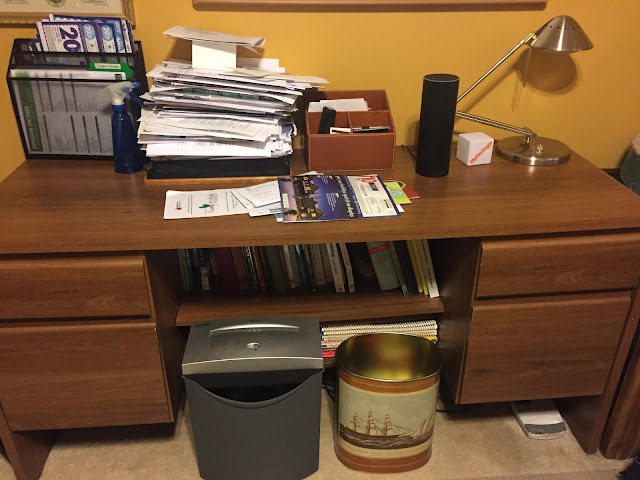As you use a workspace over time, you begin to notice those
things that aren’t working as well as they should. You may need to make small
changes to improve the efficiency of your physical space. Since I last talked
about my own space, I’ve tweaked a few things to make my workflow easier, and
so I want to talk about what it looks like now.
Over the December holidays, I spent a lot of time getting
rid of papers that were taking up valuable space in my file drawers. I did this
in anticipation of needing this space for a portion of the papers that have yet
to be filed. I soon discovered that I was keeping a number of home documents
that could easily be discarded. But because most of them were of a financial
nature, I needed to shred them instead of simply throwing them away. My
shredder was inadequate to the task, as it couldn’t handle more than five pages
at a time, and it couldn’t handle staples. I replaced the shredder (the old one
going to Goodwill) with one that could handle up to 16 pages as well as
staples, and over a few days I was able to eliminate a huge amount of unneeded
paper. I now have room for things that are currently sitting in piles.
As I started to work on the contents of one such pile (my
physical inbox), my electric stapler decided to give up the ghost. And so a
newer and more powerful stapler (up to 20 pages) was purchased and placed in
easy reach of where I sit.
One of the ways to process paper is to first scan it (and
then discard the printed copy), but my wireless printer/scanner was located on
the other side of my home office, making the scanning process a chore. I
realized that I could reorganize the space immediately to the left of my
computer so that the printer/scanner could sit at arm’s length.
The physical inbox is located a little farther away from the
computer, but a bit closer to the office door, so when the mail comes in, it’s
easy to toss things into it. There’s also a standing file for a few ongoing
projects of lower priority, mainly a place to put some things that I haven’t
yet decided what to do with. It also has a tax folder in it to dump receipts
and things through the year.
Some things haven’t changed much, because they are working
well where they are. The new shredder and a small trash can sit below the
credenza. On top of the credenza, the
pen holder (with a Trivial Pursuit logo on it) still has a single pen in it and
is easy to get to. The Amazon Echo sits there too, available to answer
questions and play music. The whiteboard sits above them, mainly used to write
a few high-priority words on if I need some focus on an urgent task. The
headphones still sit on massive push pins at the bottom of the cork board
behind the computer. The computer desk still holds the computer, the second
display, the computer speakers, the keyboard, the mouse on its mouse pad, a
holder for my phone and glasses, and a USB hub with 10 ports (mostly used for
USB flash drives or to recharge my wireless mouse). And most important of all,
the cat bed still sits immediately to the right of the second display, always
ready for my research assistant, Oxford.
There is still a lot of discarding, scanning, filing, and
shredding to be done. But I now have a physical workspace that meets the needs
of this genealogist.





